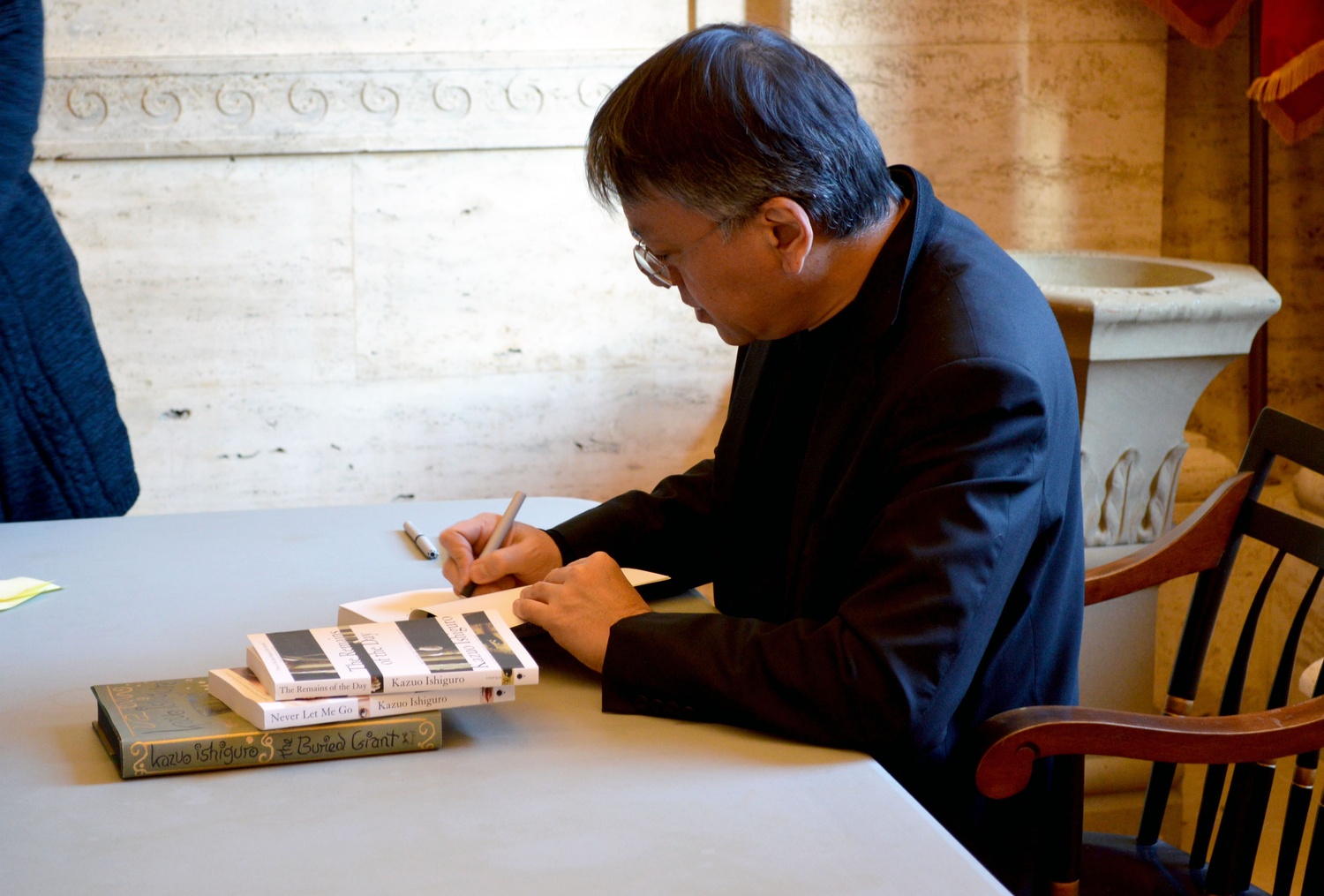The Role Of Imagination In Kazuo Ishiguro's Exploration Of Memory

Table of Contents
Kazuo Ishiguro's novels are masterclasses in the manipulation of memory, often employing unreliable narrators whose recollections are as much a product of imagination as of lived experience. Consider the haunting ambiguity of Never Let Me Go, where Kathy's hazy childhood memories intertwine with a manufactured narrative, blurring the lines between reality and constructed memory. This essay will explore the crucial role imagination plays in shaping and distorting memory within Ishiguro's works, arguing that he uses imagination not simply to depict memory, but to dissect its inherent flaws and the inherently subjective nature of the past.
<h2>Memory as a Fragile Construct in Ishiguro's Novels</h2>
Ishiguro masterfully portrays memory as a fragile, selective, and ever-evolving construct, far from a reliable record of the past. His characters grapple with incomplete recollections, susceptible to revision and influenced by present desires and anxieties. The unreliability of his narrators underscores this point, highlighting how subjective experiences shape and reshape memories over time. This concept of "constructed memory" has significant psychological implications, revealing the inherent limitations of human recollection.
- Examples from The Remains of the Day: Stevens, the meticulous butler, represses his emotions and selectively recalls his past, creating a narrative that shields him from painful truths. His meticulously detailed memories are, ironically, highly selective and incomplete.
- Examples from Never Let Me Go: Kathy's childhood memories are hazy and fragmented, pieced together with the help of her friends' recollections and their collective imagination. Their constructed narrative of their lives, including their attempts to find their "possible" donors, reveals the power of shared imagination in shaping their reality.
- Unreliable Narrators: Ishiguro frequently employs unreliable narrators whose subjective perspectives significantly influence the way they remember and recount events. This unreliability challenges the reader to question the validity of their memories and the very nature of truth.
- Constructed Memory: The concept of constructed memory, crucial to understanding Ishiguro's work, implies that memories are not simply retrieved but actively reconstructed each time they are accessed, shaped by present beliefs and experiences. This process introduces inherent biases and inaccuracies into our sense of the past.
<h2>The Power of Imagination to Fill the Gaps of Memory</h2>
Ishiguro brilliantly uses imagination to compensate for the inherent limitations of memory. Where memory falters, imagination steps in, creating narratives that both fill in the gaps and sometimes distort what truly happened. This interplay between memory and imagination often blurs the line between fact and fiction.
- Fantasy and Storytelling: In Never Let Me Go, the children engage in imaginative games and storytelling, which serve as both a coping mechanism and a way of shaping their understanding of their predetermined lives and their uncertain futures.
- Solace and Self-Deception: Imagined scenarios offer characters solace, allowing them to escape the harsh realities of their situations or to maintain comforting illusions about their past. This self-deception often stems from a desire to create a more palatable narrative.
- Blurred Lines: The constant blurring of memory and imagination makes it challenging to discern what truly occurred and what was merely imagined, leaving both characters and readers grappling with uncertainty.
- Ethical Implications: The act of manipulating or embellishing memories, as many of Ishiguro's characters do, raises ethical questions about the authenticity of self and the construction of personal narratives.
<h2>Imagination and the Exploration of Identity in Ishiguro's Works</h2>
The interplay of memory and imagination is central to the exploration of identity in Ishiguro’s novels. Characters grapple with fragmented memories, using their imaginative faculties to construct a coherent, if often flawed, sense of self.
- Fragmented Memories and Identity: Faced with incomplete or traumatic memories, characters utilize their imagination to create a sense of continuity and meaning, to establish a stable identity amidst the uncertainty.
- Trauma and Imagination: Past trauma profoundly impacts both memory and imagination. Characters might repress painful memories or create imaginative narratives to mitigate the impact of the trauma.
- Alternative Narratives: Characters often construct alternative narratives to cope with uncomfortable or painful truths, seeking to create a more positive, albeit illusory, self-image.
- Meaning and Belonging: The search for meaning and a sense of belonging is often pursued through both the examination of memories and the creation of imaginative worlds and self-narratives.
<h3>The Role of Nostalgia and Longing in Shaping Memory and Imagination</h3>
Nostalgia plays a significant role in shaping both memory and the construction of imagined pasts in Ishiguro's works. Characters often yearn for a lost past that may not have been entirely as they remember it. This yearning fuels their imaginations, creating idealized versions of the past.
- Yearning for a Lost Past: Many of Ishiguro's characters exhibit a deep longing for a simpler or more fulfilling past, a past that might be largely constructed by their own imagination and desires.
- The Desire for Something Better: The act of remembering is often intrinsically linked to a desire for something better or simpler than the present, which further distorts the accuracy of the remembered past.
- Melancholic Tone: The melancholic tone prevalent in Ishiguro's novels is directly related to this exploration of memory and imagination, highlighting the bittersweet nature of nostalgia and the unattainable ideal of a perfect past.
<h2>Conclusion: Re-examining the Interplay of Memory and Imagination in Ishiguro's Novels</h2>
This exploration of Kazuo Ishiguro's work reveals a complex and intricate relationship between memory and imagination. Ishiguro uses imagination not merely as a tool to depict memory but as a means of dissecting its subjective nature, revealing its inherent flaws and the impact of personal biases. The unreliable narrators, fragmented memories, and imaginative constructions all work together to highlight the malleability of the past and the ongoing process of identity formation. His novels demonstrate how we actively construct our memories and our selves, with imagination playing a crucial role in this ongoing process. Delve deeper into Kazuo Ishiguro's exploration of memory and imagination by reading his other novels and considering the psychological nuances of memory's literary representation. His exploration of memory's unreliable nature and the imaginative powers that shape and reshape it is a significant contribution to the understanding of human experience.

Featured Posts
-
 Bangladeshs European Strategy Collaboration And Expansion
May 25, 2025
Bangladeshs European Strategy Collaboration And Expansion
May 25, 2025 -
 Container Ship Aground On Residential Lawn The Cnn Story
May 25, 2025
Container Ship Aground On Residential Lawn The Cnn Story
May 25, 2025 -
 Fanatik Gazetesi Atletico Madrid Barcelona Macini Canli Izleyin
May 25, 2025
Fanatik Gazetesi Atletico Madrid Barcelona Macini Canli Izleyin
May 25, 2025 -
 Flood Advisories For Miami Valley Severe Storm Update
May 25, 2025
Flood Advisories For Miami Valley Severe Storm Update
May 25, 2025 -
 Living The Dream Your Escape To The Country Awaits
May 25, 2025
Living The Dream Your Escape To The Country Awaits
May 25, 2025
